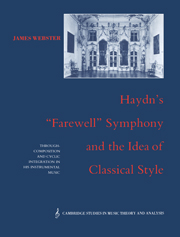 Haydn's 'Farewell' Symphony and the Idea of Classical Style
Haydn's 'Farewell' Symphony and the Idea of Classical Style Book contents
- Frontmatter
- Contents
- Foreword by Ian Bent
- Preface
- Author's note
- List of abbreviations
- Introduction
- PART I THE FAREWELL SYMPHONY
- PART II CYCLIC ORGANIZATION IN HAYDN'S INSTRUMENTAL MUSIC
- 5 Progressive form and the rhetoric of instability
- 6 Integration of the cycle
- 7 Extramusical associations
- 8 Individual compositions
- Historiographical conclusion: Haydn's maturity and “Classical style”
- Bibliography
- Index
7 - Extramusical associations
Published online by Cambridge University Press: 28 January 2010
- Frontmatter
- Contents
- Foreword by Ian Bent
- Preface
- Author's note
- List of abbreviations
- Introduction
- PART I THE FAREWELL SYMPHONY
- PART II CYCLIC ORGANIZATION IN HAYDN'S INSTRUMENTAL MUSIC
- 5 Progressive form and the rhetoric of instability
- 6 Integration of the cycle
- 7 Extramusical associations
- 8 Individual compositions
- Historiographical conclusion: Haydn's maturity and “Classical style”
- Bibliography
- Index
Summary
AUSTRIAN INSTRUMENTAL MUSIC IN HAYDN'S TIME
Every late eighteenth-century musician believed in the expressive power of music. To be sure, the nature and effects of such expression were widely disputed, in large part because of changing ideas regarding the traditional aesthetic concepts of imitation and representation, especially as applied to music. These changes were reciprocally linked to the gradually increasing autonomy of instrumental music, which eventually led to the novel Romantic belief in the superiority of what later came to be known as “absolute” instrumental music to all other art.
All this decisively altered the nature of what we today call “program music”; indeed, it effectively created the distinction between it and absolute music. We need only recall the disputes over Haydn's uses of word-painting and other forms of associational representation in The Creation and (especially) The Seasons (disputes which have not been evaluated by contemporary scholars). Beethoven's famous phrase regarding the Pastoral Symphony, “mehr Ausdruck der Empfindung als Malerey,” was doubtless intended not merely as a succinct verbalization of complex aesthetic aims, but as a preemptive defense against criticism of his program as excessively literal. His insecurity on this score, and his preference for “feelings” over “pictorialisms,” doubtless derived in part from his own ambivalence: although he was often inspired by extramusical associations, he mocked the word-painting in Haydn's late oratorios. (His later tribulations with Wellington's Victory demonstrated that these fears were not unfounded.)
The prestige of absolute music still persists, most of all in current attitudes towards the “Classical period.”
- Type
- Chapter
- Information
- Haydn's 'Farewell' Symphony and the Idea of Classical StyleThrough-Composition and Cyclic Integration in his Instrumental Music, pp. 225 - 249Publisher: Cambridge University PressPrint publication year: 1991
